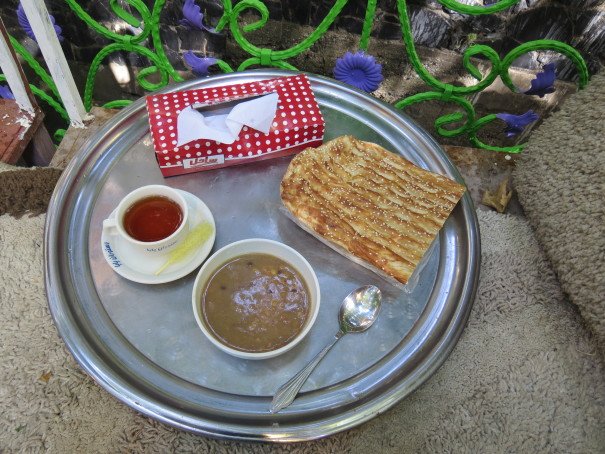
A Breakfast That Actually Does Sound Worth the Hike

A Breakfast That Actually Does Sound Worth the Hike
Adassi in Tehran
If there’s one thing that you’ll notice immediately about Tehran, it’s the picturesque mountain-range backdrop provided by the Alborz, whose 16,000-foot peaks loom high over the city below. In winter, you can ski there, and need proper snow gear to make the ascent on foot. In the height of the summer months, however, with the center of town sweltering, the mountain valleys offer some much-needed respite from the heat, traffic, and pollution.
A series of well-established cafes and eateries line the lower reaches of the most popular and accessible routes, ranging from luxurious traditional sofrekhane restaurants and some of the city’s most-loved kebab joints (lower down) to simpler fare for serious trekkers and day hikers further up. It is here that I’m aiming to reach, early one weekday morning, in search of a plain, filling dish of adassi, the heart-warming breakfast of climbers.
Over the years, the sprawl of Tehran has extended all the way up into the foothills of the mountains, which means that, unlike many other cities, there’s no need to leave town to reach the hiking trails. I take the earliest metro service north to Tajrish Square, then a five-minute taxi ride later, I’m standing at the gates of Darband.
The path, which follows the twists and turns of a rushing stream, starts out well-paved and easy on the legs, so even families with young children and the elderly can enjoy the scenery. After a couple of miles, the gradient increases and the shops and restaurants get smaller and more spaced out. Supplies have to be brought up by mule, which means there is plenty of traffic on the trail, even at this early hour. The air is cool and welcoming, with the sky bright but the sun not yet risen above the rock walls towering above the sides of the valley.
After an hour of walking, I find what I’m looking for: a friendly, tree-lined, riverside restaurant, nestled in a niche of open space between two imposing crevices. There are no seats, just wide divans, the traditional Persian carpeted and cushioned platforms for eating, relaxing, and sleeping. Removing my shoes and settling in, I order adassi and chai (tea) and listen to the rushing water below and the birdsong from the trees above.
The tray arrives minutes later, steaming in the morning air, and I eagerly tuck in, my appetite roused from the hike. The ingredients can vary, but usually include brown lentils, onions, diced potato, and spices, creating a rich, thick, warming broth. The original recipe takes true dedication, since the chef must get up and start cooking well before dawn, simmering the adassi slowly for several hours in a huge cauldron, traditionally over an open fire. It is eaten with bread—here, the sturdy workman’s barbari—and together, they’re enough to fuel a day’s labor or, in my case, an escape up to the higher slopes.
There, you have the reward of seeing Tehran unrolled like a patterned carpet beneath you, stretching almost to the horizon, with the haze below reminding you of the worthwhile effort you’ve made to clear your lungs, exercise your body, refresh your mind, and earn your breakfast.
Small-group trips with R&K
Journey alongside chefs, raconteurs, and Roads & Kingdoms for the deepest culinary tours on earth.
